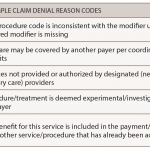Ms. Tillman says she appreciates working with practice managers like Alice P., who often bring new trends in denials to her attention so she can help others facing similar issues. She and Ms. Chung also take a proactive approach to alerting members when they hear of a change coming.
Recently, Ms. Tillman contacted Monica Archie, billing manager for Rattandeep Singh, MD, in Atlanta to alert her that an XS billing modifier was about to change. “I knew this change was coming, but I didn’t realize it had already changed. Getting the alert from the ACR saved me weeks trying to get an approval if I would have had to resubmit a corrected claim,” Ms. Archie explains.
To practice managers and billing specialists who aren’t connected with the ACR, Ms. Archie encourages taking any opportunity to seek out the expertise that Ms. Chung and Ms. Tillman offer. “You can always count on them for good advice. They are always ready to pick up the phone, email back or even meet in person with an answer to my coding and billing questions,” Ms. Archie says.
E/M Coding Changes in Practice
This year, Ms. Tillman and Ms. Chung have seen an uptick in questions from practice managers about how to accurately code the updated E/M services. One reason for these questions is the major changes to AMA CPT office and outpatient E/M codes that took effect in January 2021 to reduce administrative burden on providers and roll back some of the rigid requirements for E/M coding.
“While these changes were made to make coding easier, adapting to these changes has presented a learning curve for many,” Ms. Chung notes.
For example, providers are no longer subjected to the three key components of E/M for both new and established patients, but they can make their code selection based on the medical decision-making level or time spent on that date of service. If time is chosen, time must be documented specifically and include total time of care provided for that day. Additionally, time can now include both face-to-face and non-face-to-face time, such as reviewing a patient’s test results in preparation for their clinical visit, as long as the non-face-to-face time is provided on the date of service, Ms. Tillman explains. In addition, the history and examination component of E/M is no longer required for visits using codes 99202–99215; instead, each service should include “a medically appropriate history and/or examination” and be documented in the patient’s medical record, Ms. Chung adds.
Getting the Support You Need
Ms. Chung and Ms. Tillman encourage rheumatologists and practice managers to reach out to the ACR with questions. They also point to the ACR’s extensive collection of practice support resources, including guidance and FAQs for common administrative questions:
- Practice Publications, such as a manual on the business side of rheumatology;
- Coding resources, such as the Coding & Reimbursement Guidelines for Interprofessional Consultation Codes and how to select an E/M code based on medical decision-making or based on time;
- FAQs on E/M, infusion, inject and incident-to services; and
- Current issues on insurance advocacy.
Find more administrative support resources from the ACR and reach out to the ACR directly with a business practice question by sending an email to Ms. Tillman and Ms. Chung at [email protected].


